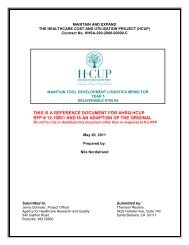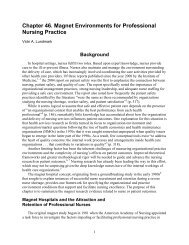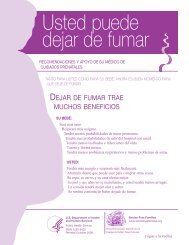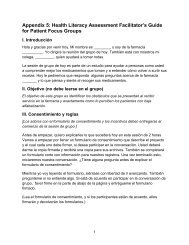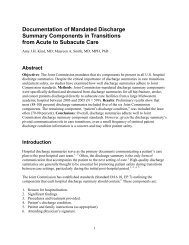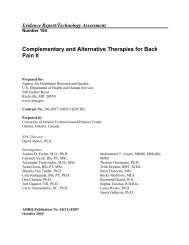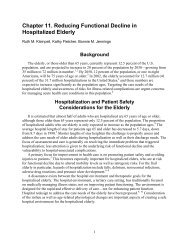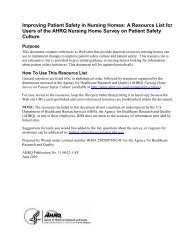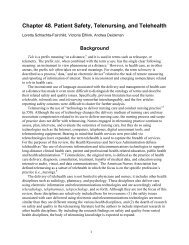Stories of Success: Using CUSP To Improve Safety - Agency for ...
Stories of Success: Using CUSP To Improve Safety - Agency for ...
Stories of Success: Using CUSP To Improve Safety - Agency for ...
Create successful ePaper yourself
Turn your PDF publications into a flip-book with our unique Google optimized e-Paper software.
Shore Health System<br />
Early in 2009, Julie Bryan, RN, CIC, Infection Prevention Coordinator, and Rob Carroll, MBA,<br />
Director <strong>of</strong> Per<strong>for</strong>mance Measurement and <strong>Improve</strong>ment, presented a new way <strong>of</strong> thinking about<br />
HAIs to the senior leadership team <strong>of</strong> Shore Health System. Bryan and Carroll knew <strong>of</strong> other<br />
institutions that had brought their infection rates to zero in a short time period, rather than<br />
improving incrementally. They proposed a similar approach. They were surprised nevertheless<br />
when their Chief Eexecutive Officer (CEO) chartered them to “make zero happen” at Shore<br />
Health and his team agreed with him. Returning to Carroll’s <strong>of</strong>fice afterward, he and Bryan<br />
looked at each other: Can we really do this? And if so, how?<br />
Target Zero: Senior Leadership, Planning, and Launch<br />
They began by setting up a multidisciplinary steering committee whose members included the<br />
Chief Medical Officer, Chief Nursing Officer, Chief Operating Officer, Director <strong>of</strong><br />
Organizational Development, and Vice President <strong>of</strong> Communications and setting up a systemwide<br />
patient safety initiative named Target Zero. It aimed to wipe out three major device-related<br />
HAIs—CLABSI, CAUTI, and VAP—and take on hand hygiene across the entire Shore Health<br />
system. A regional, not-<strong>for</strong>-pr<strong>of</strong>it network <strong>of</strong> inpatient and outpatient services serving four rural<br />
counties on the Eastern Shore <strong>of</strong> Maryland, Shore Health is composed <strong>of</strong> two hospitals that<br />
merged in 1996, a cancer center, a home healthcare and hospice agency, a multispeciality<br />
physician group, and diagnostic and ambulatory centers.<br />
The Target Zero Steering Committee began with the <strong>CUSP</strong> principle <strong>of</strong> engaging senior<br />
leadership. Bryan said, “some people’s view had been, ‘infections happen, they’re inevitable.’<br />
We had to show them research about what other hospitals had been able to do.” The immediate<br />
result, Carroll said, was that “senior leadership got fully on board, supported us, and gave us<br />
enough time to plan properly.” Leadership became so engaged that they aligned their goals and<br />
objectives with eliminating HAIs, provided a budget, held managers and directors accountable,<br />
participated in safety rounds and hand hygiene rounds, participated on the various committees<br />
involving Target Zero, empowered staff to do the right thing, reviewed monthly data and<br />
progress reports, and attended celebrations <strong>for</strong> units achieving zero HAIs <strong>for</strong> at least a year.<br />
Over the next several months, Bryan, Carroll, and the Medical Director <strong>for</strong> Quality identified<br />
best practices <strong>for</strong> infection prevention from the literature. They also, Bryan said, “found out a lot<br />
about <strong>CUSP</strong> online at the Michigan Keystone ICU Project website to draw on <strong>for</strong> Target Zero.”<br />
The steering committee suggested doing a SWOT (strengths, weaknesses, opportunities, threats)<br />
analysis, which was carried out through 50 interviews with people throughout the system to get a<br />
baseline on how they thought about infections, and listen <strong>for</strong> opportunities to improve and to<br />
achieve zero. Committee members discussed best ways to get employee buy-in. They also talked<br />
with award-winning hospitals, borrowing materials from one that had had enormous success with<br />
hand hygiene.<br />
On September 24, 2009, the Steering Committee <strong>for</strong>mally launched Target Zero, which was<br />
attended by the entire senior leadership team. They discussed the initiative and their expectations<br />
at a meeting <strong>of</strong> 100 directors and managers. The CEO charged them with getting to zero HAIs,<br />
and aligning their resources with this goal. He gave them three principles: Imagine zero is<br />
possible, make zero part <strong>of</strong> the culture, and have fun doing it. Senior executives from marketing,<br />
16





